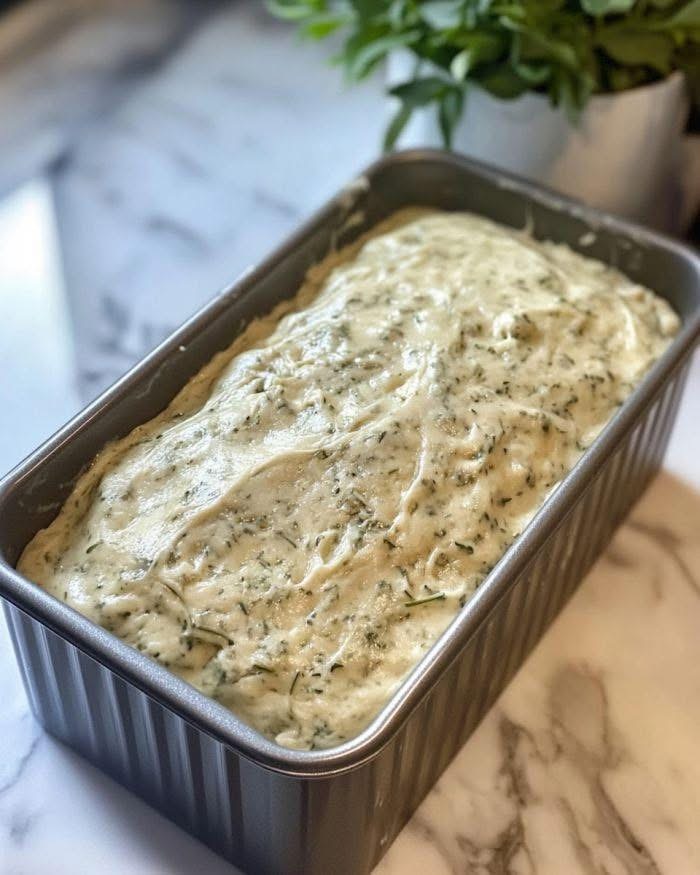Dill Herb Bread A Timeless Aromatic Delight

Introduction
Dill Herb Bread is a savory, aromatic bread known for its rich flavor and versatility. With its roots in Eastern European and Mediterranean cuisines, dill bread is a wonderful companion to soups, stews, or as a flavorful base for sandwiches. The infusion of fresh dill and sometimes garlic or cheese adds depth, making it beloved by home bakers and gourmet chefs alike.
Ingredients
For the dough:
- 3 cups all-purpose flour
- 1 tbsp sugar
- 2¼ tsp (1 packet) active dry yeast
- 1 cup warm milk (about 110°F / 43°C)
- 2 tbsp unsalted butter, melted
- 1 tsp salt
- 1 egg
- ¼ cup chopped fresh dill (or 1 tbsp dried dill)
- 1 tbsp dried onion flakes (optional)
- ½ cup sour cream or Greek yogurt (adds richness and moisture)
Instructions & Method
- Activate the Yeast:
- In a large mixing bowl, combine warm milk, sugar, and yeast.
- Let it sit for 5–10 minutes until it becomes frothy.
- Mixing the Dough:
- Add the melted butter, egg, sour cream, salt, dill, and onion flakes to the yeast mixture.
- Gradually add in the flour, 1 cup at a time, mixing until a soft dough forms.
- Kneading:
- Knead the dough on a floured surface for about 8–10 minutes, until it becomes smooth and elastic.
- First Rise:
- Place the dough in a greased bowl, cover with a damp towel or plastic wrap.
- Let rise in a warm place for 1–1.5 hours, or until doubled in size.
- Shaping & Second Rise:
- Punch down the dough and shape it into a loaf.
- Place in a greased loaf pan (as seen in your image).
- Let rise again for 30–45 minutes.
- Baking:
- Preheat oven to 375°F (190°C).
- Bake for 30–35 minutes, or until golden brown on top and sounds hollow when tapped.
- Cooling:
- Let the bread cool in the pan for 10 minutes, then transfer to a wire rack to cool completely before slicing.
History of Herb Breads
Herbed breads trace their origins to ancient civilizations where herbs were used both for flavor and preservation. Dill, a staple in Slavic, Greek, and Middle Eastern kitchens, found its way into breads centuries ago. These breads were often baked in communal ovens and shared during festivals, symbolizing nourishment and togetherness
Benefits of Dill Herb Bread
- Digestive Aid: Dill is known for aiding digestion and relieving bloating.
- Rich in Antioxidants: Fresh herbs contain potent antioxidants that help fight inflammation.
- Heart-Healthy: Using olive oil or yogurt instead of butter can make this bread heart-friendly.
- Protein & Calcium: Adding yogurt or sour cream boosts protein and calcium content.
Formation
The bread forms a light, tender crumb with a slightly chewy crust. Herbs like dill and onion evenly infuse the dough, and the rising process ensures a fluffy, well-aerated structure, as beautifully shown in your image.
Lovers of Dill Herb Bread
- Artisan Bakers: Love it for the balance of rustic flavor and simplicity.
- Vegetarians & Vegans: Easily adaptable with plant-based substitutions.
- Soup Enthusiasts: Perfect accompaniment for soups like borscht or creamy potato.
- Kids & Adults Alike: Mild yet flavorful enough to please all palates.
Nutrition (Per Slice, Approximate)
- Calories: 170
- Carbs: 26g
- Protein: 5g
- Fat: 5g
- Fiber: 1g
- Sodium: 220mg
Nutrition can vary based on specific ingredients used.
Conclusion
Dill Herb Bread is more than a delicious side — it’s a comforting, flavorful staple that connects tradition with modern culinary creativity. Whether you enjoy it fresh from the oven with butter, toasted with cheese, or as part of a hearty meal, this bread brings joy, aroma, and nourishment to the table.
To All the Dill Bread Lovers
To those who cherish the simplicity of homemade bread, who smile at the scent of herbs rising from a warm oven, and who understand that love is kneaded into every loaf — this bread is for you.